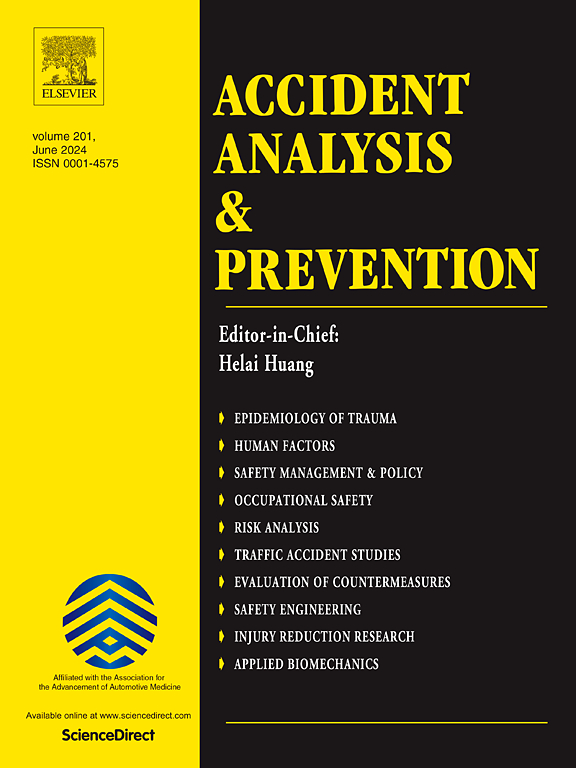基于自行车摔倒实验的车把最大允许扰动模型,预测了自行车恢复平衡的能力
IF 6.2
1区 工程技术
Q1 ERGONOMICS
引用次数: 0
摘要
跌倒是骑自行车者受伤的一个重要原因,这突出了有效预防跌倒干预措施的必要性。然而,对于设计更安全的基础设施和自行车的工程师,以及制定培训计划的安全专业人员来说,对这些干预措施的事前评估仍然具有挑战性。本研究提出最大允许车把干扰(MAHD)——骑自行车者可以从最大的车把外部干扰中恢复——作为评估预防跌倒干预措施的性能指标。虽然自行车动力学和骑自行车者控制模型有可能确定这一指标并模拟干预措施,但它们的应用目前受到限制,因为在预测MAHD方面缺乏验证,而且现有骑自行车者控制模型中可纳入的干预措施范围狭窄。为了解决这些局限性,我们对24名不同年龄和技能水平的参与者进行了对照实验,将他们暴露在冲动性的车把干扰中,导致恢复和跌倒。该数据集包括骑车者摔倒的记录,支持自行车动力学和控制模型在预测MAHD时的未来验证。此外,利用贝叶斯平均模型,我们确定了影响MAHD的关键骑行因素,其中前进速度和骑行者平衡技能是关键的预测因素。将这些预测因子纳入自行车控制模型可以大大提高其实际应用。然后将这些见解用于开发贝叶斯多水平逻辑回归模型,以预测不同类型骑自行车者的MAHD。我们的研究结果提高了自行车动力学和控制模型的潜力,以主动评估骑自行车者摔倒预防方法,有助于更安全的骑行环境。本文章由计算机程序翻译,如有差异,请以英文原文为准。
A model based on cyclist fall experiments which predicts the maximum allowable handlebar disturbance from which a cyclist can recover balance
Falls are a significant cause of injury among cyclists, highlighting the need for effective fall prevention interventions. However, ex-ante evaluation of such interventions remains challenging for engineers designing safer infrastructure and bicycles, as well as for safety professionals developing training programs. This study proposes the Maximum Allowable Handlebar Disturbance (MAHD) — the largest external handlebar disturbance a cyclist can recover from — as a performance indicator for evaluating fall prevention interventions. While bicycle dynamics and cyclist control models have the potential to determine this indicator and simulate interventions, their application is currently limited by a lack of validation in predicting the MAHD and the narrow range of interventions that can be incorporated into existing cyclist control models. To address these limitations, we conducted controlled experiments with 24 participants of varying ages and skill levels, exposing them to impulse-like handlebar disturbances that resulted in both recoveries and falls. This dataset, which includes recorded cyclist falls, supports future validation of bicycle dynamics and control models in predicting the MAHD. In addition, using Bayesian Model Averaging, we identified key cyclist factors influencing the MAHD, with forward speed and cyclist balancing skill being critical predictors. Incorporating these predictors into cyclist control models can substantially improve their practical application. These insights were then used to develop a Bayesian multilevel logistic regression model to predict the MAHD for different types of cyclists. Our findings improve the potential for bicycle dynamics and control models to proactively evaluate cyclist fall prevention methods, contributing to safer cycling environments.
求助全文
通过发布文献求助,成功后即可免费获取论文全文。
去求助
来源期刊

Accident; analysis and prevention
Multiple-
CiteScore
11.90
自引率
16.90%
发文量
264
审稿时长
48 days
期刊介绍:
Accident Analysis & Prevention provides wide coverage of the general areas relating to accidental injury and damage, including the pre-injury and immediate post-injury phases. Published papers deal with medical, legal, economic, educational, behavioral, theoretical or empirical aspects of transportation accidents, as well as with accidents at other sites. Selected topics within the scope of the Journal may include: studies of human, environmental and vehicular factors influencing the occurrence, type and severity of accidents and injury; the design, implementation and evaluation of countermeasures; biomechanics of impact and human tolerance limits to injury; modelling and statistical analysis of accident data; policy, planning and decision-making in safety.
 求助内容:
求助内容: 应助结果提醒方式:
应助结果提醒方式:


